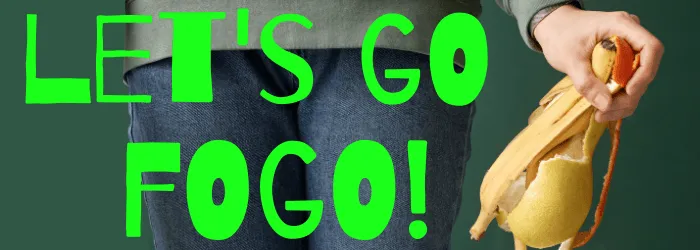FOGO

Do you have FOMO about FOGO?
Do you have Fear Of Missing Out about Food Organics Garden Organics? We’ve got the lowdown – so let’s go-go!
There’s a new bin in town! Meet the FOGO (Food Organics Garden Organics) bin….
What the?
FOGO is a kerbside collection service that allows food scraps to be added to garden waste bin so it can be recycled into top quality compost. Right now, only around 30% of Australian households have access to FOGO collection services, and the Federal Government has said a national rollout won’t happen until the end of this decade, pushing back the original target of 2023.
Why collect FOGO?
Each year, Australians throw away 7.3 million tonnes of food – this equals about 300kg per person. Add to this the garden organics (grass clippings, timber, other garden waste) and the average rubbish bin contains about 50% of organic waste that gets dumped in landfill. The problem is that here, organic matter creates methane as it decomposes, a greenhouse gas about 80 times more potent than CO2.
Organic matter matters
Organic matter is rich in nutrients and energy. While the best strategy to minimise unnecessary greenhouse gas emissions from food waste would be to avoid waste in the first place, recycling the organic matter is crucial.
Currently, only about 49% of organic waste is recycled in Australia, with rates varying from 75% in ACT to 1% in the Northern Territory
We need to put a spotlight on what many farmers already know: organic waste is valuable! Not only do we need to do better and keep more waste out of landfill where resources are lost; but we also need to create recycling systems that feed the organic matter back where it belongs – in the ground.
Organic waste collected in FOGO bins is processed to create nutrient-rich, weed-free compost that can be used on farms, in parks and as fertiliser.
How is the FOGO bin different from the green bin?
Many councils already offer a green bin for garden collection, but how is it different from a FOGO bin? The FOGO bins swallows all your organic waste. That includes all garden and food waste (including meat and fish scraps and dairy products), animal droppings, kitty litter as well as paper and cardboard, whereas the green bin typically only takes garden waste such as grass clippings and wood trimmings.
Where does FOGO go?
As with your recycling bin, there might be different FOGO providers in different council regions who collect and process the waste. The FOGO waste is taken to the provider’s composting facility for industrial composting. After checking the waste for contamination, it will undergo a rapid composting process under high temperature.
Is FOGO composting different from composting at home?
There are a few differences between home composting and commercial composting.
While it is not recommended to compost meat, fish and some other table scraps at home (think vermin…), they all can go into the commercial composter. Bulky items such as cardboard and garden trimmings are too large and would take too long to break down in your home composter but can be composted commercially thanks to the pre-processing that FOGO waste undergoes to create a uniform mass of smaller chunks. Then there are items such as kitty litter, and cups that are labelled as “compostable” but need high temperatures to break down. They would not disintegrate in your garden compost but can be composted in the high-temperature commercial composter.
What can you do to keep organic waste out of landfill?
Go FOGO when the time comes!
Councils are progressively rolling out FOGO bins to their residents, so you may not be lucky enough to have a FOGO bin yet (currently, only around 30% of all Australians have access to a full FOGO collection service). Breathe easy though, through the National Waste Policy Action Plan, states and territories have agreed to introduce FOGO collection services to all households and businesses by end-2023. If you’re still waiting, why not get proactive and contact your local council to ask about the timeframe for your area? Many councils ask passionate and enthusiastic local residents to become “FOGO Ambassadors” and provide access to educational workshops, enabling you to speak to your neighbours about the coming changes and be a source of knowledge for the local community.
Reduce kitchen waste
This may seem obvious but is actually the most effective way to reduce food waste ending up in landfill and creating unnecessary emissions. According to the Rabobank 2020 Food Waste report, Aussies are now wasting 12.7% of their weekly grocery shop, costing the average Australian household an all-time high $1,043 per year and totalling $10.3 billion nationally. Check out our useful tips and resources on how to reduce food waste in your home.
Don’t “wishcycle”!
You may be keen to fill up your green bin or FOGO bin to contribute to composting of organic waste. But even small amounts of contaminating material such as plastic or metal can lead to the whole load being rejected by the composting facility and ending up in landfill. Follow your local council’s guide on what can and can’t go in the bin. When in doubt, put it in the rubbish bin.
Compost at home!
Until you receive a FOGO bin, composting your food waste and keeping a worm farm are excellent ways to keep organic waste out of landfill and create nutrient-rich compost and worm tailings for your garden or pot plants. And trust us, living in an apartment is no excuse these days! If you’re still not convinced, you need to check out ShareWaste – it’s a free app that connects people who wish to recycle their kitchen scraps with neighbours who are already composting, worm-farming or keeping chickens.
